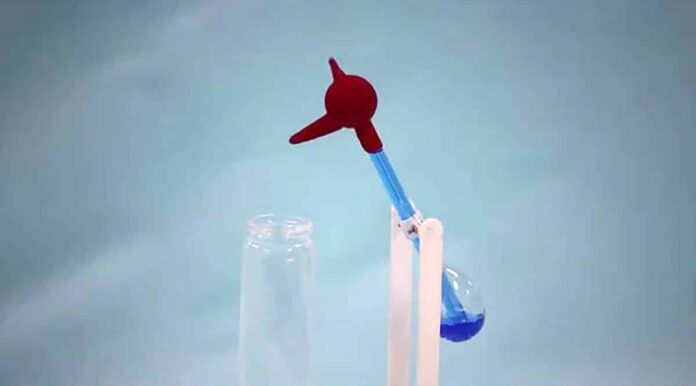Water evaporation is a promising source of clean energy due to its significant energy transfer on Earth. Various hydrovoltaic techniques have been proposed to convert evaporation energy into electricity, but these techniques mainly rely on streaming potential, which has limitations in terms of low voltage output.
Inspired by the classic drinking bird toy, scientists in Hong Kong and Guangzhou, China, have developed an engine that can generate electricity from water evaporation. This engine can produce energy outputs exceeding 100 volts and operate for several days using only 100 milliliters of water. The generator could one day power a wide variety of small electronics in a sustainable and efficient way.
“The drinking bird triboelectric hydrovoltaic generator offers a unique means to power small electronics in ambient conditions, utilizing water as a readily available fuel source,” said Hao Wu, a professor at South China University of Technology and the first author of the study. “I still feel surprised and excited when witnessing the actual results.”
Children’s drinking bird toy also called a “dippy bird,” has been popular in science classrooms for many years. Its vacuum-sealed body consists of two glass bulbs connected by a glass tube with a highly volatile liquid, methylene chloride, stored within. The top bulb, which includes the bird’s beak and a decorative top hat, is covered in a felt-like material, and the bird’s body is suspended on two plastic legs.
After the bird’s head is dipped in a glass of water, the water begins to evaporate. This creates a pressure difference, causing the fluid in the bottom bulb to rise up through the tube and fill the head. This causes the bird to dip forward into the water as if it’s taking a drink, and the process starts again.
Wu, a postdoc in Prof. Zuankai Wang’s group at The Hong Kong Polytechnic University, was trying to figure out how to create a greater voltage output from an evaporation energy generator when she thought of the drinking bird toy. She realized that the toy could be used for more than just a physics demonstration.
Wu had the idea to convert the evaporation energy into mechanical energy and then translate that into electricity. That’s when she thought of using the drinking bird toy as inspiration for a new concept: the drinking bird triboelectric hydrovoltaic generator.
Wu and colleagues placed two triboelectric nanogenerator modules on both sides of the bird engine to collect mechanical energy to construct the generator. The prototype was tested with a variety of small electronics, including 20 liquid crystal displays (LCDs), temperature sensors, and calculators.
According to Wu, one of the biggest challenges in their study was overcoming the friction slowing down the generator. To address this, the researchers used patterned fibers as the charge transfer materials in the triboelectric nanogenerator modules. This strategy effectively reduced friction significantly, allowing the device to operate more smoothly.
In the next phase, the team plans to take their research to the next level by designing a new drinking bird from scratch instead of using a commercially available toy. Their goal is to create a device that can more efficiently convert water evaporation to electrical energy.
“Additionally, we will explore various application opportunities for this device with the ultimate aim of delivering a practical product that can be used in our daily lives,” said Zuankai Wang, the corresponding author of this study and a chair professor at Hong Kong Polytechnic University.
